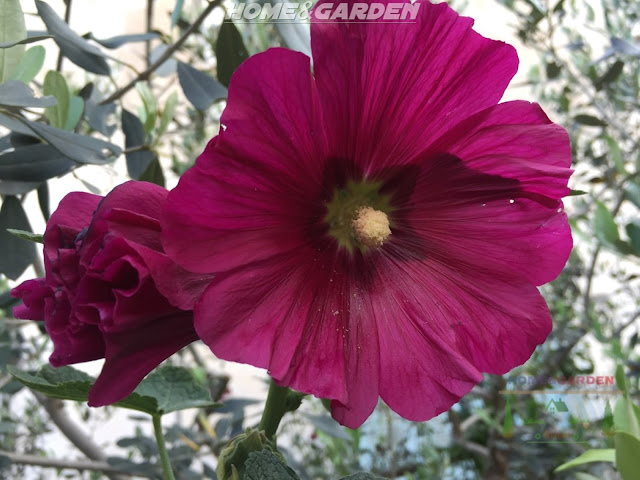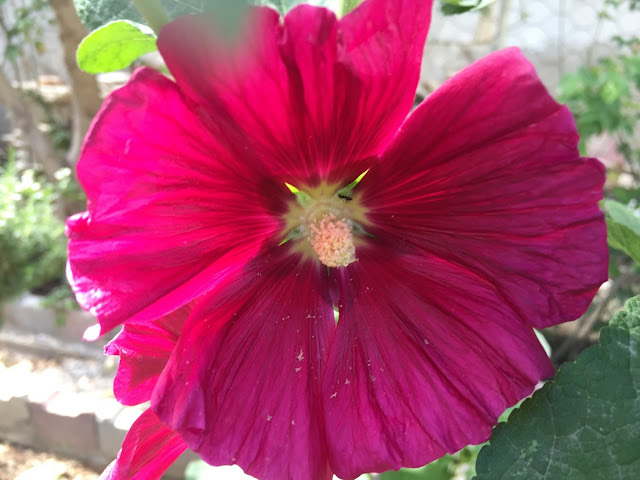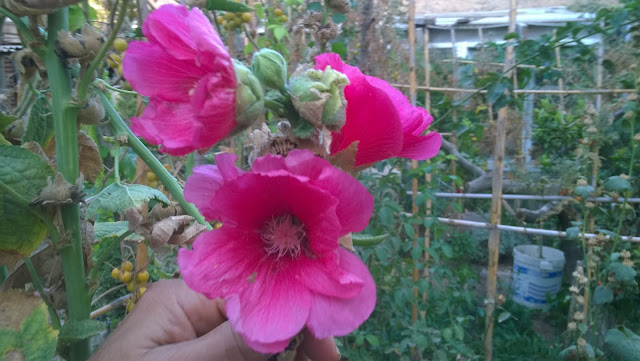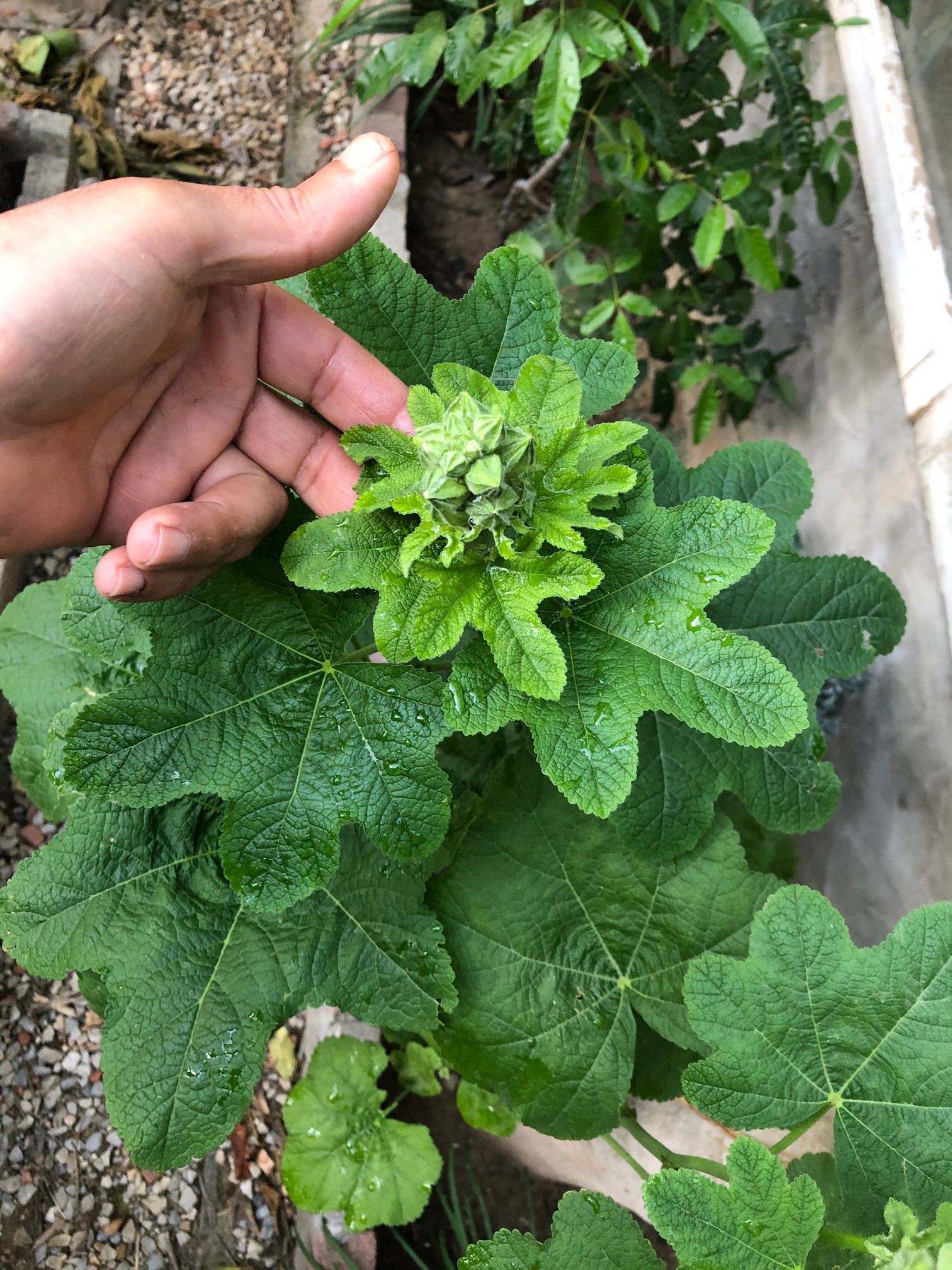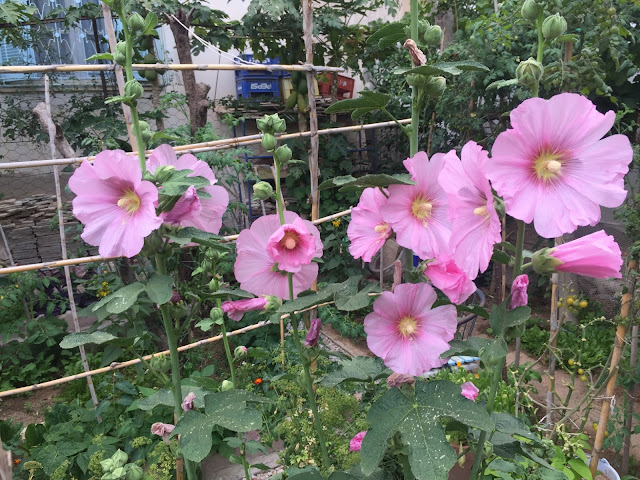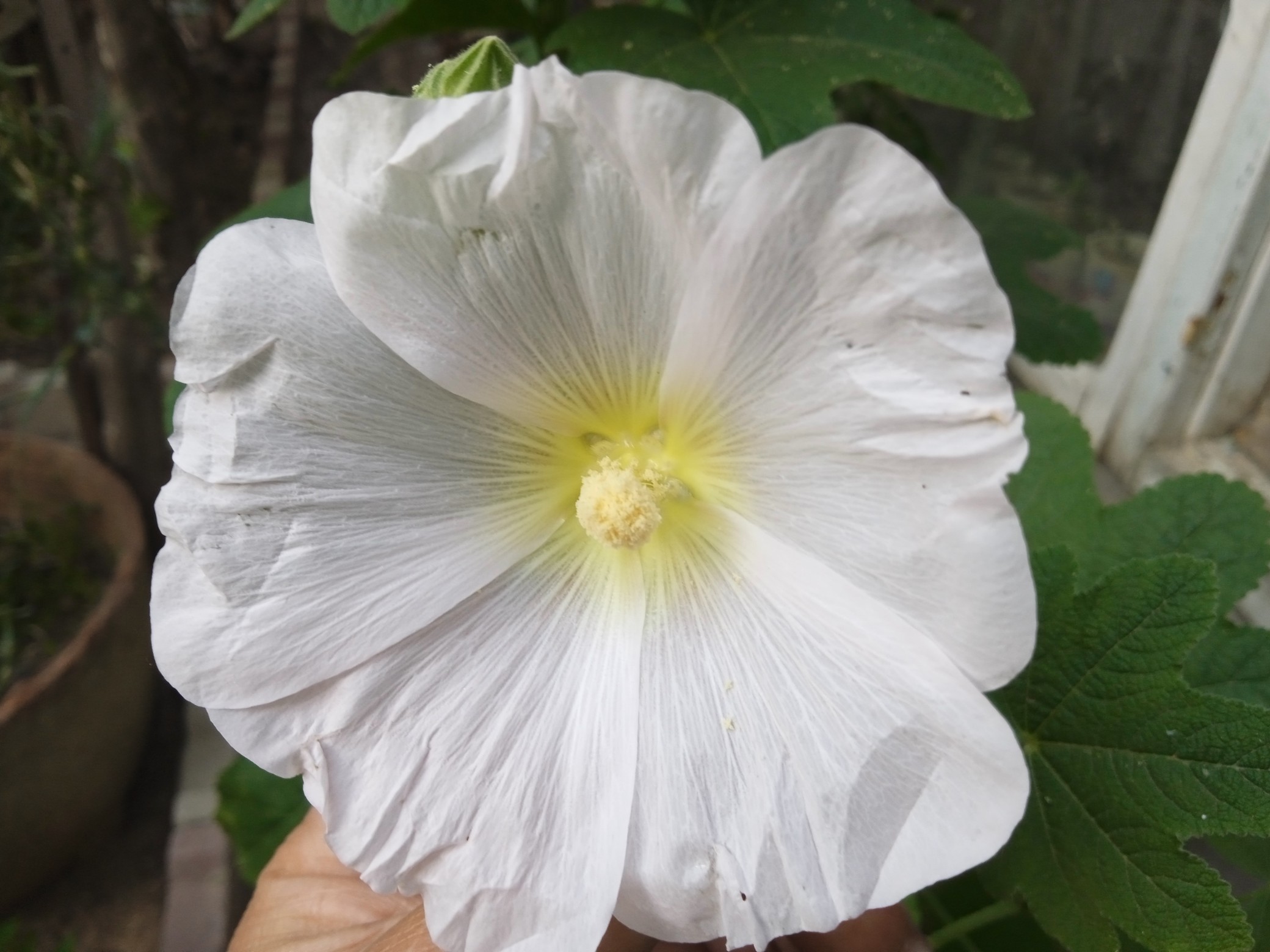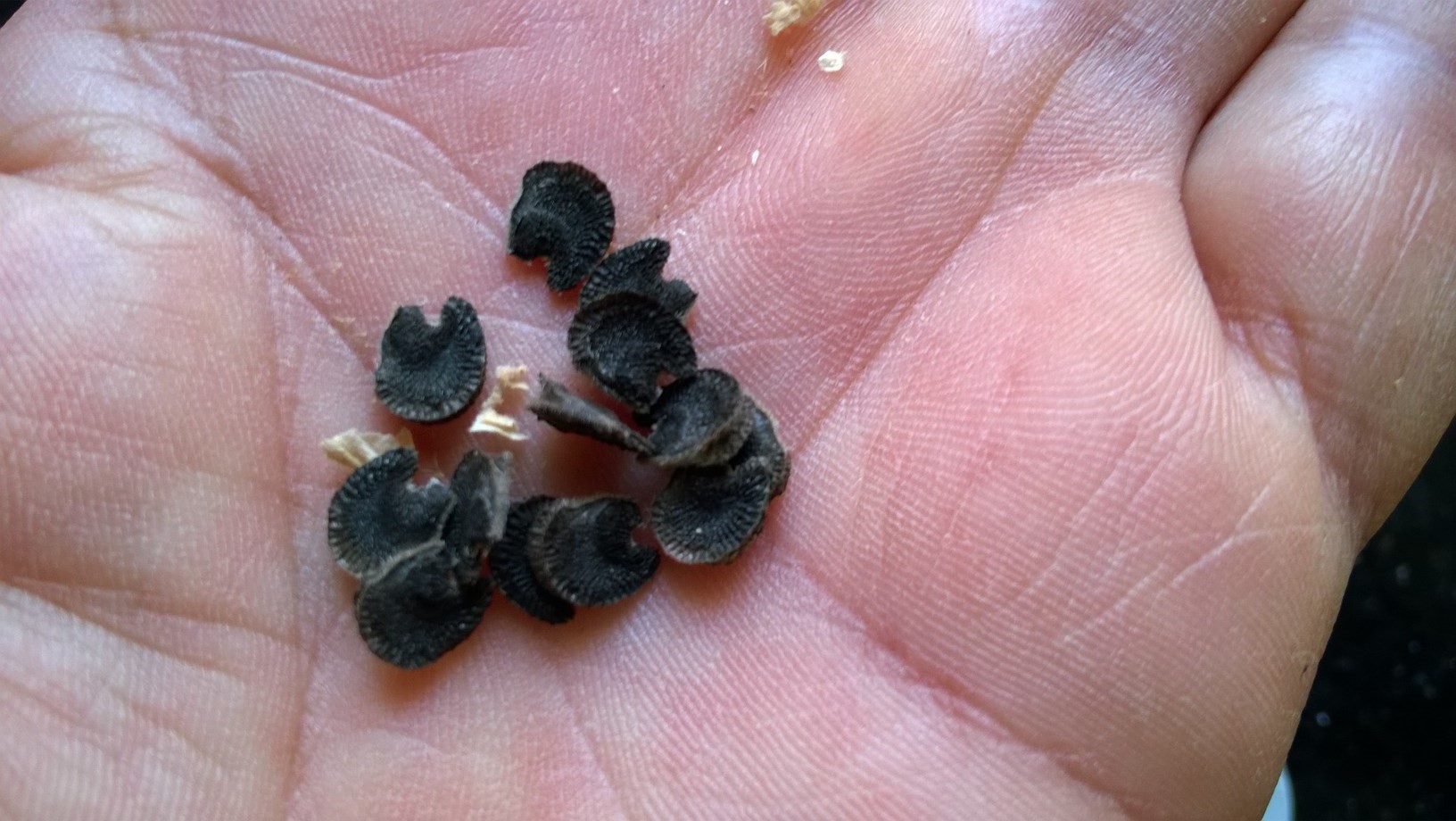Hollyhocks are in the mallow family, the same family as hibiscus. Hollyhocks are biennials or short-lived perennials. Biennial means that the plant requires two years to complete it life cycle. During the first year, hollyhocks grow a root system and a rosette of leaves. The second year, their flowering stems emerge, and they bloom. People all across the world have grown and loved hollyhocks for a very long time. Thanks to the success of the cottage-garden style. Hollyhocks originated in Asia and the area around the Eastern Mediterranean Sea. Hollyhocks (Alcea rosea) belong to the mallow family. The botanical name comes from the Latin word 'altheo,' which means 'to cure,' because some hollyhocks have medicinal properties. Today, most of us grow hollyhocks for their ornamental value. While their stunning stalks and flowers have made them favorites of many generations of gardeners, it is their medicinal value that most appealed to the earliest growers. Over the centuries, salves and teas made from different parts of the plant were used to cure many diffrent things. Hollyhocks are completely edible, which means that you can grow them to make your garden so beautiful, but they are also perfect for creating a revitalizing tea. You can even crystallize the flowers to make stunning cake decorations.
With its luminous colors and beautiful flowers, a valued asset for every garden. The real eye-catcher of the hollyhock is its height and its beautiful flowers. The flowers attracts attention with their huge blossoms which shine in several bright colors. Hollyhocks Origine
The origin of the hollyhock flower lies in eastern and southern Europe as well as the middle and far-eastern region. Its genus was first published in the year 1753 by Carl von Linné in the species plantarum. Albert Spear Hitchcock and Jesse Robinson Green determined the (alcea rosea) as a Lectotypus in the year 1929 in the standard-species of Linnaean genera of phaneograms.
Watch In My Garden Video -Hollyhocks-
Hollyhocks Profile
. Plant family: Mallow family (Malvaceae)
. Genus: Hollyhock (Alcea)
. Species: Ordinary hollyhock (Alcea rosea)
. Trivial name: Hollyhock, common hollyhock, common peony.
. Origin: Balkans, Southern to Eastern Europe, middle and far-eastern region
. Perennial, herbaceous plant.
. Hollyhocks height up to 1 to 2 m, some times the plant can reach up to 3 m.
. Hollyhocks have multi-colored and vibrant bowl-shaped blossoms ranging in color from pink and red to white, yellow, and black.
. Hollyhock Flowering period depends on location and begin between May and September. Here in my area Hollyhocks bloom from early to midsummer until the frost in the fall.
. Hollyhocks have deciduous, rounded, dented, rough and big leaves.
. It's a biennial, hermaphrodite, self-seeding plant.
Hollyhocks Varieties
Hollyhocks come in various colors, and there are also some dwarf varieties Adaptive to most any garden location, different varieties of hollyhocks are suited to either shade, partial shade or full sun. Many colorful varieties are also very drought tolerant, once established. Hollyhocks are truly beautiful, and there are a number of different varieties that you can choose from.
If you want a specific colour of hollyhock flower to grow then you will need to buy seeds.
From HERE you can purchase hollyhock seeds in your choice of variety and color!
Alcea rosea is the most common type of cultivated hollyhock. These old-fashioned hollyhocks are tall and stately, blooming over a long summer season through the first frost.
Alcea ficifolia, commonly known as fig-leafed hollyhock, presents deeply lobed leaves and white- or cream-colored flowers. The plant produce an abundance of flowers from May through October. Fig leaf hollyhocks are resistant to hollyhock rust.
Alcea rugosa produces bold yellow flowers. The plant is very easy to cultivate and grows well in full sun or partial shade and prefer well-drained soil with a pH of 5.5 to 6.0.
Hollyhock Flowers
Hollyhock with its big flowers is an old ornamental favourite, the flower spans about 3-5" when it is fully open. The flowers are produced on very long stalks that tower over the garden. Hollyhock flowers can be a variety of vibrant colors ranging from white, yellow, and pastel pink to lovely shades of red, blue, and purple. Some of hollyhock flowers are so dark they are nearly black.
These bell-shaped flowers feature papery petals that resemble crêpe paper. Flowers can be both single and double petaled with the double (or full) petaled varieties resembling a lovely carnation.
As a biennial plant hollyhocks self-seed freely germinating in the summer and forming a rosette of new foliage by fall. Hollyhocks flowers bloom along the spire opening from the bottom of the spire and work their way to the top.
Hollyhocks range in height from 3 to 8 feet, depending on the cultivar and the growing conditions. These tall flowers are ideal along fences, or planted against buildings and if you live in a windy location, they often need some support to keep them upright.
Hollyhocks Meaning and Symbolism
Hollyhocks symbolize the circle of life, ambition, love, abundance and fertility .
They have traditionally been planted near the front door of homes to welcome prosperity. Egyptians frequently placed wreaths of hollyhocks with the mummified to help them in their journey to the afterlife. The color of the flower can also affect the intrinsic meaning and symbolism of the hollyhock in the language of flowers:
. The red hollyhock flower symbolizes love, romance, and passion.
. The purple hollyhock flower represents charm and grace, but can also symbolize a transition. Purple is often a regal color, symbolic of royalty, tradition, and standing.
. The white hollyhock flower symbolizes innocence, purity, honesty, and fertility.
. The pink hollyhock flower symbolize sensitivity, love, and thoughtfulness.
. The yellow hollyhock flower symbolizes friendship, trust, and respect.
Suitable Gifting Occasions for Hollyhocks
Hollyhock flowers are a suitable gift for housewarmings, promotions, graduations, and birthdays. Hollyhock plants, especially if they are being passed on from someone’s garden, are a great way to celebrate the circle of life and wish good luck and abundance to the recipient!
Hollyhocks Etymological Meaning
Traditional sources say the hollyhock derives its name from the Old English word holi meaning holy and hoc meaning mallow, but there are other explanations worth considering. According to legend, the hollyhock got its name because it was brought from the Holy Land.
The Edible Parts of Hollyhock
. Hollhocks young leaves can be used raw or cooked. They have a mild flavour, but the texture leaves something to be desired. They can be chopped up finely and added to salads.. Inner portion of young stems can be used raw.
. Flower petals and flower buds can be added to salads and a refreshing tea is made from them too.
. The root of Hollyhock treats digestive problems. Research shows that this amazing herb have the ability to treat enteritis, colitis, peptic and ulcers.
. Hollyhock seeds can be used in a hot tisane to help reduce the symptoms of fevers.
Benefits And Uses Of Hollyhocks
Hollyhock is not only to be used for gardening uses, but this amazing plant is also valuable to promote the health benefits for sure. Hollyhocks have a rich history as herbal remedies. All parts of the hollyhock plant are edible and have been used for herbal treatments. Hollyhock possesses various medicinal values and treats various health ailments. This medicinal plant helps to treat cough, cold, fever, stomach problems, prevents the kidney stones and relieves the chest congestion. You can use hollyhock as an edible way to add vibrant color to your foods and get a boost of flavonoids in your diet. "Flavonoids are rich in antioxidant activity and can help your body ward off everyday toxins"!
The Amazing Benefits Of The Hollyhock Flowers
. Hollyhocks flower can be used in a variety of dishes. All parts of the flower are edible, but the petals of the flower in particular have a slightly sweet flavor. The flowers are demulcent, diuretic and emollient. They are useful in the treatment of chest complaints, and a decoction is used to improve blood circulation, for the treatment of constipation, dysmenorrhoea, haemorrhage and they are harvested when they are fully open and are dried for later use. The flower petals are also used to color jellies, jams, and other confections and beverages whilst the flower petals and buds can be added to salads.
. Hollyhock tea made from the flower petals is thought to ease digestive issues, the tea can help you to cure some diseases. For the example, it will be good for the treatment of a sore throat, and even treat the loss of appetite as it has anti-inflammatory properties. Apart from Hollyhock ability to cure a sore throat, it's very helpful to cure fever and cold as well. You can have it by crushing some flowers, if you want to give sweetness to the tea add some sugar or honey. This natural tea will help your body in detoxification. Thus, your body will get hydrated as the result of natural treatment from hollyhock. Indeed, this herbal tea will comfort and relax your body then.
. The decoction made of hollyhock root and flowers will help to ease the kidney and womb irritation in the women. What makes hollyhock becomes the great natural treatment is the way it also helps treating vaginal ejection.
. Hollyhock an be used as an herbal tea to help soothe inflammation of tissues in the gastrointestinal, genitourinary, and respiratory tracts.
. The root and flowers of Hollyhock plant eases the kidney.
. The root and leaves of Hollyhock treats the digestive problems.
. Hollyhock is a great moisturizer for the skin. This medicinal herb also treats dry skin and provides soft skin.
Insect Bites
If you get insect bites, hollyhock can help you. It has shown that hollyhock takes part in treating the itchiness from insect bites. Also, it will help to relieve the discomfort of the burns as well. You can apply some crushed leaves of hollyhock to the affected area.
Hollyhocks are not poisonous. They are not on the list of plants that are poisonous to humans or animals, so you can rest assured that they are safe to have around your home, backyard and garden. While they may be old-fashioned flowers, hollyhocks definitely deserve a spot in today’s gardens due to their tall stature and large, colorful blooms. I love growing hollyhock as it brings beauty to my organic garden, and offer many health benefits!
Now that you know all the benefits of hollyhock, give it a try and grow it to enjoy their beautiful flowers in borders or against walls and fences where their spectacular flowers stand tall above all else!
Please let us know your thoughts, experiences, or questions in the comments below. If you like this, you can share with your friends!
It is so important to consult your doctor before using Hollyhock to treat any condition, as it may interact with medications. All information provided on this website is for informational purposes only. Please seek professional advice before commencing any treatment!
DISCLAIMER:
aromatic-herbs-growing is a participant in the Amazon Services LLC Associates Program, an affiliate advertising program designed to provide a means for sites to earn advertising fees by advertising and linking to Amazon. Pages on this site may include affiliate links to Amazon and its affiliate sites on which the owner of this website will make a referral commission.



